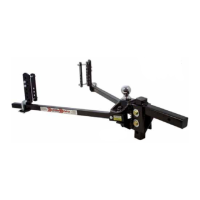14
www.equalizerhitch.com
Figure 7a
Insert two 1/2” x 1-1/2” bolts through
each outside link plate from the back side.
The slot in the back should keep the head
of the bolt from rotating.
Thread a 1/2” x 3-1/2” bolt through the
single hole of the outside and inside link
plates from the outside in. The head of the
bolt should be against the outside link plate
with the bolt pointing inward. Put a split
washer on the bolt and thread a nut onto the end of bolt a few turns. Slide
the link plates over the frame as shown so that the bolts for the L-bracket
studs are facing outward.
Thread the second bolt through the link plate holes closest to the trailer
frame with the head on the outside. Put a split washer on the bolt and thread
the nut onto it from the back side. Refer to Figure 7b for bolt placement
based on your trailer frame height. Pinch the inside and outside link plates
tight to the trailer frame so that both
lay at against the frame. Inside link
plates are sometimes slightly bowed
from the manufacturing process. If
this is the case, the center of the bow
should be placed toward the trailer
frame so that as they are tightened
they atten out against the frame.
Continue holding them in place
while you hand tighten both nuts. Use
wrenches to nish tightening the link
plate bolts until they are snug, alter-
nating from top to bottom 1/2 turn at
a time. Bolts and nuts should be fairly
tight, but do not over tighten them. Link plates must be at against trailer
frame to work correctly. Uneven or over tightening may cause link plates to
bow and “walk” along frame. See Figure 8.
Do not use impact wrench to tighten link plate or L-bracket bolts.
Figure 7b

